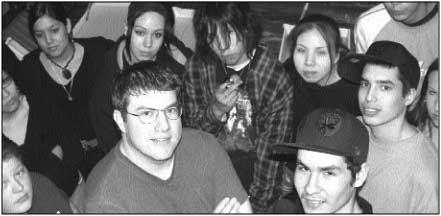Against All Odds
The Struggles of Native Youth in Toronto
Shaneeka Melanson
The transition from middle school to high school is complicated enough, but just imagine doing it all alone. Most of us are 13 or 14 when we enter high school; most of us also have support and encouragement from our family and friends. But what if you didn’t?
For many people this is simply a hypothetical “what if,” but unfortunately for many Native Canadians across Canada that question is very much a reality. Almost 40% of Native Canadians have less than a high school education; these numbers may seem alarming to some but fortunately they are decreasing.
In 1996, 45% of Native Canadians had less than a high school education. Due to lack of resources many Native people who live on reserves will never have a chance to even consider secondary education, let alone post secondary.
It’s easy to become another number, to become another statistic, to feed into this vicious cycle. So we ask ourselves, “When will it stop?” When will the Native youth of this generation realize that they deserve and are worth so much more?
The answer is so simple: when they learn. It may be a bit ironic, but the only way for Native youth to realize how capable they are is to make them aware of the resources that are available. There are so many beneficial programs out there that go unnoticed and unrecognized every day, and one in particular is actually part of Jarvis.
Katie Longboat, a student at the Native Learning Centre, said when asked what obstacles she faced in a mainstream high school, “My biggest problem was that I didn’t fit in.” She also said that people would ask her questions like, “Don’t Native people drop out?” or other harsh generalizations like that.
Jarvis Collegiate and the Native Child and Family Services of Toronto have been running a Native alternative school for six years now. Over the years it has grown from two teachers and two courses, to four teachers and eight courses. The school expanded so successfully that it is now currently in need of a new building.
Everyone who is affiliated with the Native Learning Centre values and appreciates the partnership with Jarvis Collegiate. Bill Schmut, coordinator of the Native Learning Centre, said, “Our affiliation with Jarvis Collegiate Institute and the T.D.S.B. is an important link for the success of the Native Learning Centre. Coordination, teamwork and problem solving help alleviate some of the issues that the staff at Native Child and Family Services of Toronto and Jarvis Collegiate deal with.”
Native youth from all across Ontario have moved to Toronto just to enroll in this very original school. When asked what she liked about the Native Learning Centre, Katie said, “I feel that many students are going through and have experienced similar things that I have. Everyone knows why we are the way we are. They understand that we are trying to move forward and our history as Native people.”
The program is flexible and aware of the problems around Native youth, and each student is free to learn at his or her own pace. It is a relaxed environment where youth are free to express and be themselves; in fact, individuality is encouraged. “I like that the classes are smaller and more laid back,” said Christopher Flynn, who is also a student at the Native Learning Centre. He enrolled this year and so far is enjoying the school’s comfortable environment.
Although the program is strictly educational and follows all aspects of the curriculum given by the T.D.S.B., it still manages to find a way to squeeze in traditional teachings.
Katie Longboat explains: “The Native Learning Centre has many opportunities to enrich and explore our culture, like pow-wows, socials, and sweat lodge ceremonies. Even the little things like smudging the drop-in every morning, or having sharing circles, helps us students of the Native Learning Centre stay in touch with our culture.”
Another student at the Native Learning Centre, Leeann Sageyaweosa, said, “I like the Native Learning Centre because it keeps you in touch with your roots.”
The program maintains a fundamentally traditional aspect. It doesn’t take the Native out of the youth, but helps feed the hunger for traditional awareness. The school puts together field trips and overnight trips that are full of teachings. Last year and this year, the students participated in a winter camping trip where students learned how to set up traps and how to prepare the meat after it has been caught. They also learned how to find Native medicines and how to properly navigate a dog sled. “The trip was pretty good, I learned a lot and enjoyed the sledding,” adds Rainy Rivers, another student.
Opportunities like this help Native youth realize the endless possibilities that are available to them- all they have to do is want it. More programs like this should become accessible to the Native youth across Canada so that they can break free from the chains of assimilation, and show a passion for education.
Now is the time for Native youth to enrich their minds, to make success out of doubt, and to succeed against all odds.

No comments:
Post a Comment